Managerial Economics Case Study: The 2008 GFC & UAE Banking Sector
VerifiedAdded on 2023/06/15
|23
|12514
|290
Case Study
AI Summary
This case study analyzes the impact of the 2008 Global Financial Crisis (GFC) on the banking sector in the United Arab Emirates (UAE), applying managerial economics concepts to understand the economic factors contributing to the crisis and its subsequent effects on UAE banks, the economic market, and employment within the banking sector. It aims to provide an in-depth understanding of how the GFC affected the UAE's banking system, including specific banks that were impacted, the broader economic consequences for the UAE, and the resulting effects on bank employees, such as terminations. The study follows a structured format, including an abstract, introduction, body, and conclusion, adhering to specific formatting guidelines (Times New Roman, 12pt font, 1.5 spacing) and APA style referencing, utilizing free online articles, journals, books, and websites as sources.
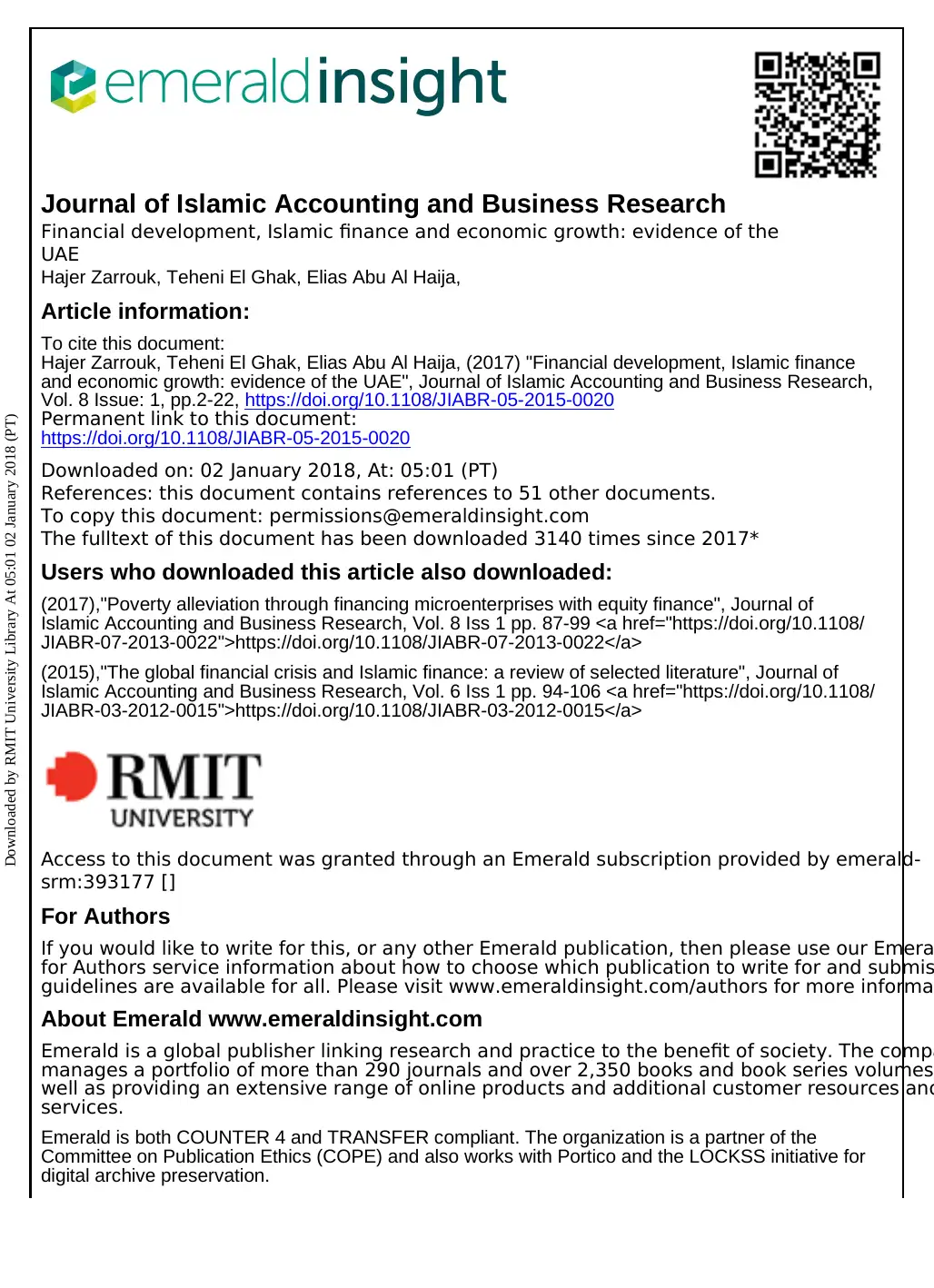
Journal of Islamic Accounting and Business Research
Financial development, Islamic finance and economic growth: evidence of the
UAE
Hajer Zarrouk, Teheni El Ghak, Elias Abu Al Haija,
Article information:
To cite this document:
Hajer Zarrouk, Teheni El Ghak, Elias Abu Al Haija, (2017) "Financial development, Islamic finance
and economic growth: evidence of the UAE", Journal of Islamic Accounting and Business Research,
Vol. 8 Issue: 1, pp.2-22, https://doi.org/10.1108/JIABR-05-2015-0020
Permanent link to this document:
https://doi.org/10.1108/JIABR-05-2015-0020
Downloaded on: 02 January 2018, At: 05:01 (PT)
References: this document contains references to 51 other documents.
To copy this document: permissions@emeraldinsight.com
The fulltext of this document has been downloaded 3140 times since 2017*
Users who downloaded this article also downloaded:
(2017),"Poverty alleviation through financing microenterprises with equity finance", Journal of
Islamic Accounting and Business Research, Vol. 8 Iss 1 pp. 87-99 <a href="https://doi.org/10.1108/
JIABR-07-2013-0022">https://doi.org/10.1108/JIABR-07-2013-0022</a>
(2015),"The global financial crisis and Islamic finance: a review of selected literature", Journal of
Islamic Accounting and Business Research, Vol. 6 Iss 1 pp. 94-106 <a href="https://doi.org/10.1108/
JIABR-03-2012-0015">https://doi.org/10.1108/JIABR-03-2012-0015</a>
Access to this document was granted through an Emerald subscription provided by emerald-
srm:393177 []
For Authors
If you would like to write for this, or any other Emerald publication, then please use our Emera
for Authors service information about how to choose which publication to write for and submis
guidelines are available for all. Please visit www.emeraldinsight.com/authors for more informa
About Emerald www.emeraldinsight.com
Emerald is a global publisher linking research and practice to the benefit of society. The compa
manages a portfolio of more than 290 journals and over 2,350 books and book series volumes
well as providing an extensive range of online products and additional customer resources and
services.
Emerald is both COUNTER 4 and TRANSFER compliant. The organization is a partner of the
Committee on Publication Ethics (COPE) and also works with Portico and the LOCKSS initiative for
digital archive preservation.
Downloaded by RMIT University Library At 05:01 02 January 2018 (PT)
Financial development, Islamic finance and economic growth: evidence of the
UAE
Hajer Zarrouk, Teheni El Ghak, Elias Abu Al Haija,
Article information:
To cite this document:
Hajer Zarrouk, Teheni El Ghak, Elias Abu Al Haija, (2017) "Financial development, Islamic finance
and economic growth: evidence of the UAE", Journal of Islamic Accounting and Business Research,
Vol. 8 Issue: 1, pp.2-22, https://doi.org/10.1108/JIABR-05-2015-0020
Permanent link to this document:
https://doi.org/10.1108/JIABR-05-2015-0020
Downloaded on: 02 January 2018, At: 05:01 (PT)
References: this document contains references to 51 other documents.
To copy this document: permissions@emeraldinsight.com
The fulltext of this document has been downloaded 3140 times since 2017*
Users who downloaded this article also downloaded:
(2017),"Poverty alleviation through financing microenterprises with equity finance", Journal of
Islamic Accounting and Business Research, Vol. 8 Iss 1 pp. 87-99 <a href="https://doi.org/10.1108/
JIABR-07-2013-0022">https://doi.org/10.1108/JIABR-07-2013-0022</a>
(2015),"The global financial crisis and Islamic finance: a review of selected literature", Journal of
Islamic Accounting and Business Research, Vol. 6 Iss 1 pp. 94-106 <a href="https://doi.org/10.1108/
JIABR-03-2012-0015">https://doi.org/10.1108/JIABR-03-2012-0015</a>
Access to this document was granted through an Emerald subscription provided by emerald-
srm:393177 []
For Authors
If you would like to write for this, or any other Emerald publication, then please use our Emera
for Authors service information about how to choose which publication to write for and submis
guidelines are available for all. Please visit www.emeraldinsight.com/authors for more informa
About Emerald www.emeraldinsight.com
Emerald is a global publisher linking research and practice to the benefit of society. The compa
manages a portfolio of more than 290 journals and over 2,350 books and book series volumes
well as providing an extensive range of online products and additional customer resources and
services.
Emerald is both COUNTER 4 and TRANSFER compliant. The organization is a partner of the
Committee on Publication Ethics (COPE) and also works with Portico and the LOCKSS initiative for
digital archive preservation.
Downloaded by RMIT University Library At 05:01 02 January 2018 (PT)
Paraphrase This Document
Need a fresh take? Get an instant paraphrase of this document with our AI Paraphraser
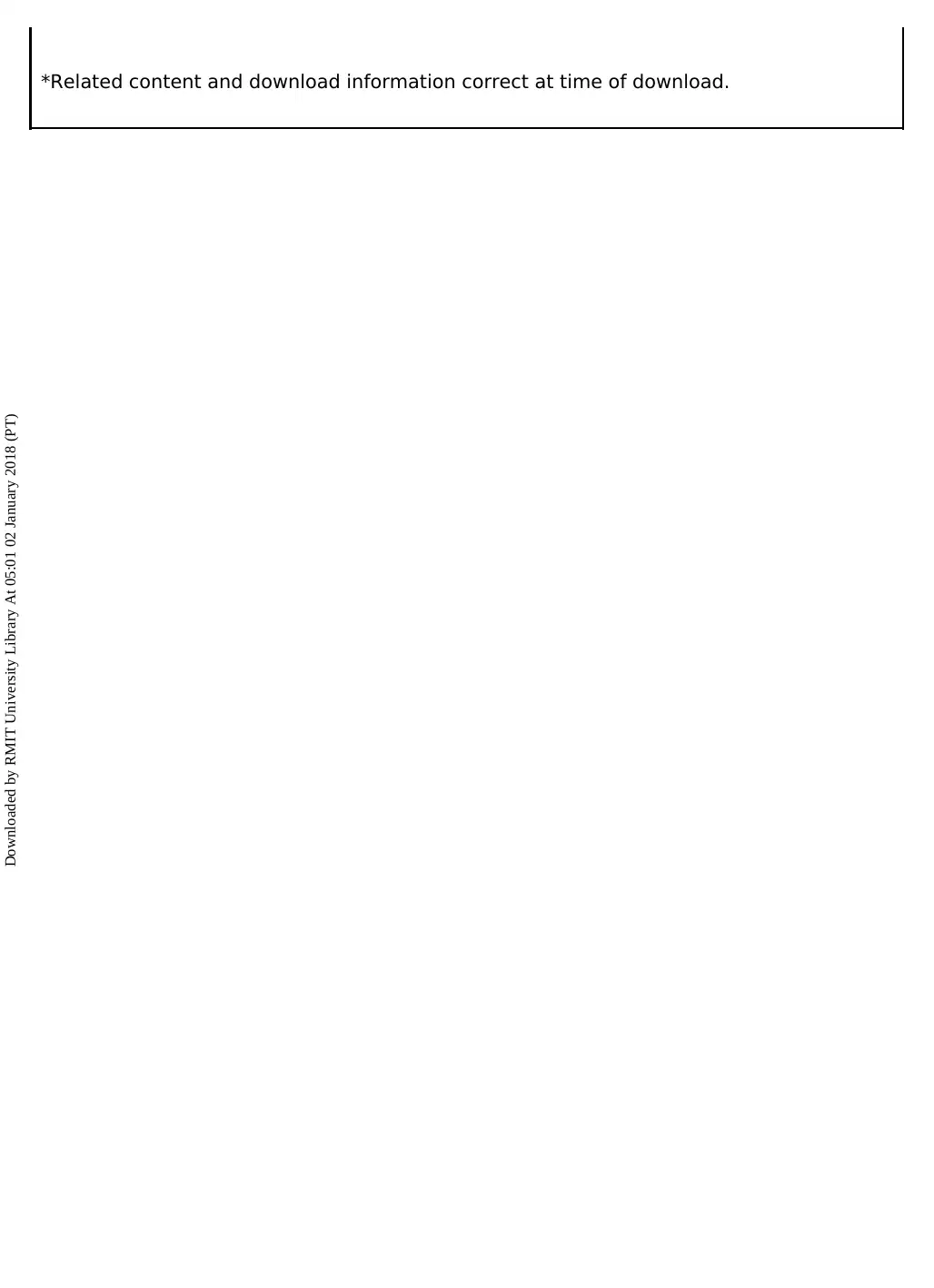
*Related content and download information correct at time of download.
Downloaded by RMIT University Library At 05:01 02 January 2018 (PT)
Downloaded by RMIT University Library At 05:01 02 January 2018 (PT)
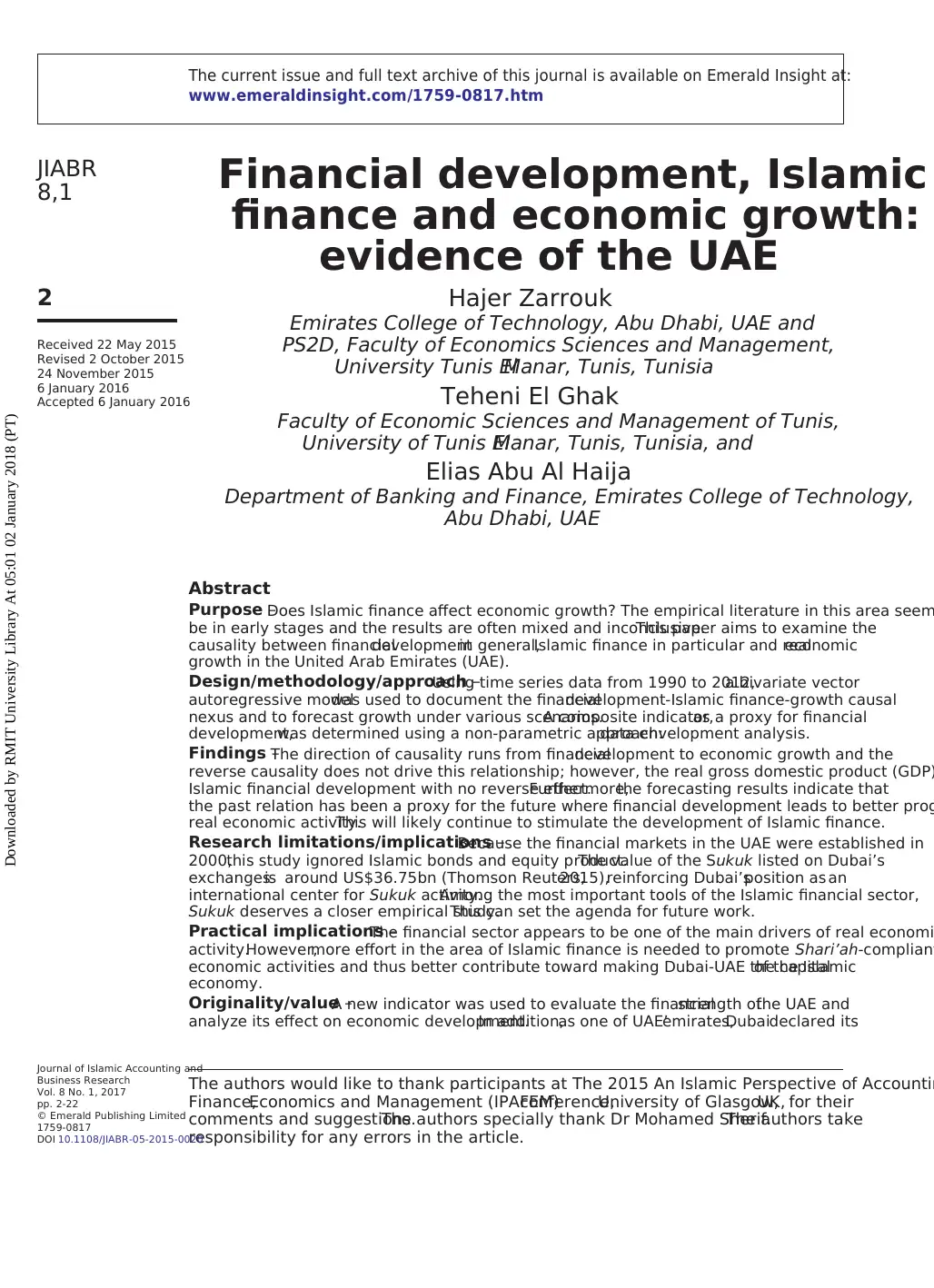
Financial development, Islamic
finance and economic growth:
evidence of the UAE
Hajer Zarrouk
Emirates College of Technology, Abu Dhabi, UAE and
PS2D, Faculty of Economics Sciences and Management,
University Tunis ElManar, Tunis, Tunisia
Teheni El Ghak
Faculty of Economic Sciences and Management of Tunis,
University of Tunis ElManar, Tunis, Tunisia, and
Elias Abu Al Haija
Department of Banking and Finance, Emirates College of Technology,
Abu Dhabi, UAE
Abstract
Purpose –Does Islamic finance affect economic growth? The empirical literature in this area seem
be in early stages and the results are often mixed and inconclusive.This paper aims to examine the
causality between financialdevelopmentin general,Islamic finance in particular and realeconomic
growth in the United Arab Emirates (UAE).
Design/methodology/approach –Using time series data from 1990 to 2012,a bivariate vector
autoregressive modelwas used to document the financialdevelopment-Islamic finance-growth causal
nexus and to forecast growth under various scenarios.A composite indicator,as a proxy for financial
development,was determined using a non-parametric approach:data envelopment analysis.
Findings –The direction of causality runs from financialdevelopment to economic growth and the
reverse causality does not drive this relationship; however, the real gross domestic product (GDP)
Islamic financial development with no reverse effect.Furthermore,the forecasting results indicate that
the past relation has been a proxy for the future where financial development leads to better prog
real economic activity.This will likely continue to stimulate the development of Islamic finance.
Research limitations/implications –Because the financial markets in the UAE were established in
2000,this study ignored Islamic bonds and equity product.The value of the Sukuk listed on Dubai’s
exchangesis around US$36.75bn (Thomson Reuters,2015),reinforcing Dubai’sposition as an
international center for Sukuk activity.Among the most important tools of the Islamic financial sector,
Sukuk deserves a closer empirical study.This can set the agenda for future work.
Practical implications –The financial sector appears to be one of the main drivers of real economi
activity.However,more effort in the area of Islamic finance is needed to promote Shari’ah-compliant
economic activities and thus better contribute toward making Dubai-UAE the capitalof the Islamic
economy.
Originality/value –A new indicator was used to evaluate the financialstrength ofthe UAE and
analyze its effect on economic development.In addition,as one of UAE’emirates,Dubaideclared its
The authors would like to thank participants at The 2015 An Islamic Perspective of Accountin
Finance,Economics and Management (IPAFEM)conference,University of Glasgow,UK, for their
comments and suggestions.The authors specially thank Dr Mohamed Sherif.The authors take
responsibility for any errors in the article.
The current issue and full text archive of this journal is available on Emerald Insight at:
www.emeraldinsight.com/1759-0817.htm
JIABR
8,1
2
Received 22 May 2015
Revised 2 October 2015
24 November 2015
6 January 2016
Accepted 6 January 2016
Journal of Islamic Accounting and
Business Research
Vol. 8 No. 1, 2017
pp. 2-22
© Emerald Publishing Limited
1759-0817
DOI 10.1108/JIABR-05-2015-0020
Downloaded by RMIT University Library At 05:01 02 January 2018 (PT)
finance and economic growth:
evidence of the UAE
Hajer Zarrouk
Emirates College of Technology, Abu Dhabi, UAE and
PS2D, Faculty of Economics Sciences and Management,
University Tunis ElManar, Tunis, Tunisia
Teheni El Ghak
Faculty of Economic Sciences and Management of Tunis,
University of Tunis ElManar, Tunis, Tunisia, and
Elias Abu Al Haija
Department of Banking and Finance, Emirates College of Technology,
Abu Dhabi, UAE
Abstract
Purpose –Does Islamic finance affect economic growth? The empirical literature in this area seem
be in early stages and the results are often mixed and inconclusive.This paper aims to examine the
causality between financialdevelopmentin general,Islamic finance in particular and realeconomic
growth in the United Arab Emirates (UAE).
Design/methodology/approach –Using time series data from 1990 to 2012,a bivariate vector
autoregressive modelwas used to document the financialdevelopment-Islamic finance-growth causal
nexus and to forecast growth under various scenarios.A composite indicator,as a proxy for financial
development,was determined using a non-parametric approach:data envelopment analysis.
Findings –The direction of causality runs from financialdevelopment to economic growth and the
reverse causality does not drive this relationship; however, the real gross domestic product (GDP)
Islamic financial development with no reverse effect.Furthermore,the forecasting results indicate that
the past relation has been a proxy for the future where financial development leads to better prog
real economic activity.This will likely continue to stimulate the development of Islamic finance.
Research limitations/implications –Because the financial markets in the UAE were established in
2000,this study ignored Islamic bonds and equity product.The value of the Sukuk listed on Dubai’s
exchangesis around US$36.75bn (Thomson Reuters,2015),reinforcing Dubai’sposition as an
international center for Sukuk activity.Among the most important tools of the Islamic financial sector,
Sukuk deserves a closer empirical study.This can set the agenda for future work.
Practical implications –The financial sector appears to be one of the main drivers of real economi
activity.However,more effort in the area of Islamic finance is needed to promote Shari’ah-compliant
economic activities and thus better contribute toward making Dubai-UAE the capitalof the Islamic
economy.
Originality/value –A new indicator was used to evaluate the financialstrength ofthe UAE and
analyze its effect on economic development.In addition,as one of UAE’emirates,Dubaideclared its
The authors would like to thank participants at The 2015 An Islamic Perspective of Accountin
Finance,Economics and Management (IPAFEM)conference,University of Glasgow,UK, for their
comments and suggestions.The authors specially thank Dr Mohamed Sherif.The authors take
responsibility for any errors in the article.
The current issue and full text archive of this journal is available on Emerald Insight at:
www.emeraldinsight.com/1759-0817.htm
JIABR
8,1
2
Received 22 May 2015
Revised 2 October 2015
24 November 2015
6 January 2016
Accepted 6 January 2016
Journal of Islamic Accounting and
Business Research
Vol. 8 No. 1, 2017
pp. 2-22
© Emerald Publishing Limited
1759-0817
DOI 10.1108/JIABR-05-2015-0020
Downloaded by RMIT University Library At 05:01 02 January 2018 (PT)
⊘ This is a preview!⊘
Do you want full access?
Subscribe today to unlock all pages.

Trusted by 1+ million students worldwide
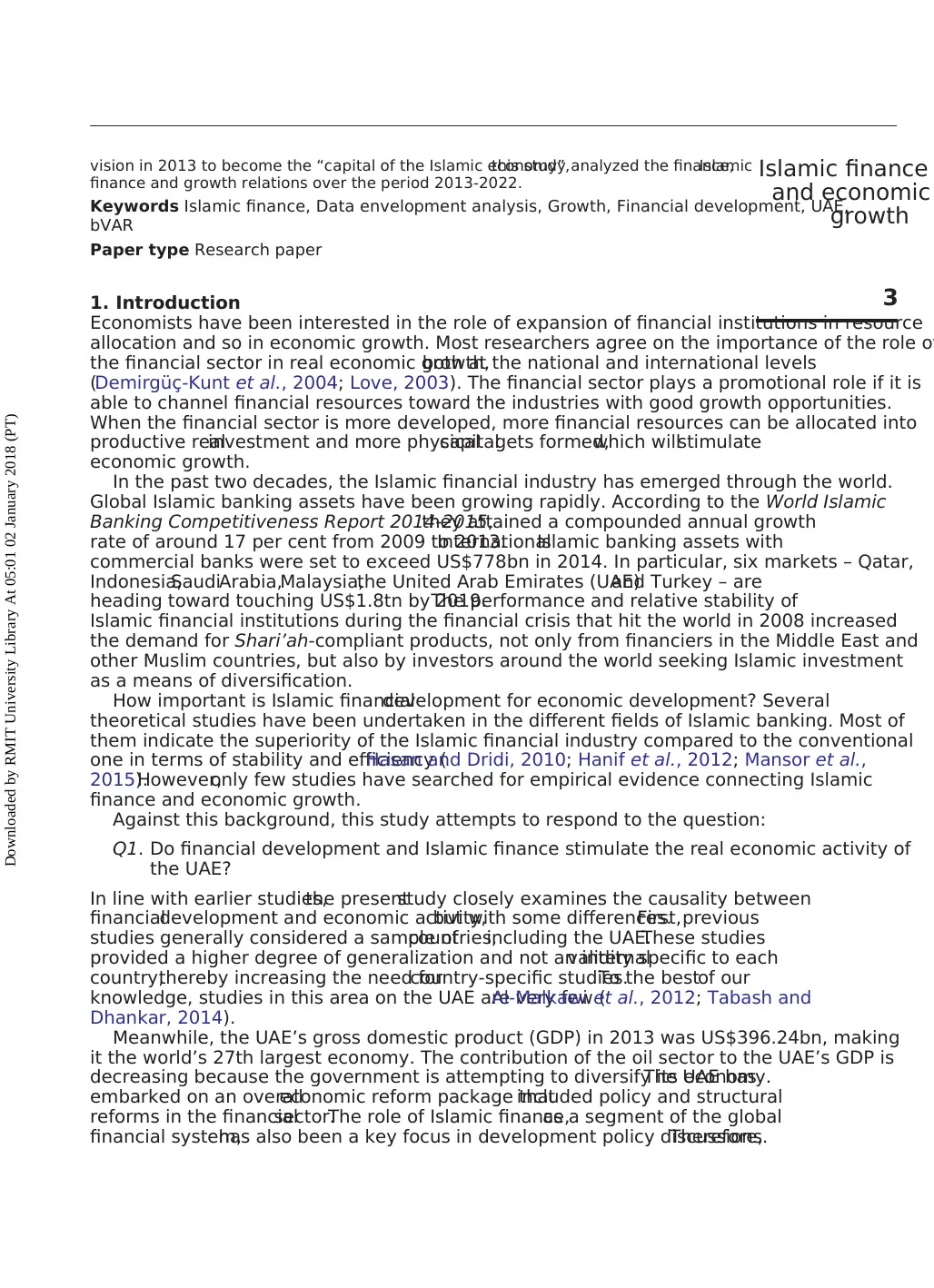
vision in 2013 to become the “capital of the Islamic economy”,this study analyzed the finance,Islamic
finance and growth relations over the period 2013-2022.
Keywords Islamic finance, Data envelopment analysis, Growth, Financial development, UAE,
bVAR
Paper type Research paper
1. Introduction
Economists have been interested in the role of expansion of financial institutions in resource
allocation and so in economic growth. Most researchers agree on the importance of the role of
the financial sector in real economic growth,both at the national and international levels
(Demirgüç-Kunt et al., 2004; Love, 2003). The financial sector plays a promotional role if it is
able to channel financial resources toward the industries with good growth opportunities.
When the financial sector is more developed, more financial resources can be allocated into
productive realinvestment and more physicalcapitalgets formed,which willstimulate
economic growth.
In the past two decades, the Islamic financial industry has emerged through the world.
Global Islamic banking assets have been growing rapidly. According to the World Islamic
Banking Competitiveness Report 2014-2015,they attained a compounded annual growth
rate of around 17 per cent from 2009 to 2013.InternationalIslamic banking assets with
commercial banks were set to exceed US$778bn in 2014. In particular, six markets – Qatar,
Indonesia,SaudiArabia,Malaysia,the United Arab Emirates (UAE)and Turkey – are
heading toward touching US$1.8tn by 2019.The performance and relative stability of
Islamic financial institutions during the financial crisis that hit the world in 2008 increased
the demand for Shari’ah-compliant products, not only from financiers in the Middle East and
other Muslim countries, but also by investors around the world seeking Islamic investment
as a means of diversification.
How important is Islamic financialdevelopment for economic development? Several
theoretical studies have been undertaken in the different fields of Islamic banking. Most of
them indicate the superiority of the Islamic financial industry compared to the conventional
one in terms of stability and efficiency (Hasan and Dridi, 2010; Hanif et al., 2012; Mansor et al.,
2015).However,only few studies have searched for empirical evidence connecting Islamic
finance and economic growth.
Against this background, this study attempts to respond to the question:
Q1. Do financial development and Islamic finance stimulate the real economic activity of
the UAE?
In line with earlier studies,the presentstudy closely examines the causality between
financialdevelopment and economic activity,but with some differences.First,previous
studies generally considered a sample ofcountries,including the UAE.These studies
provided a higher degree of generalization and not an internalvalidity specific to each
country,thereby increasing the need forcountry-specific studies.To the bestof our
knowledge, studies in this area on the UAE are very few (Al-Malkawi et al., 2012; Tabash and
Dhankar, 2014).
Meanwhile, the UAE’s gross domestic product (GDP) in 2013 was US$396.24bn, making
it the world’s 27th largest economy. The contribution of the oil sector to the UAE’s GDP is
decreasing because the government is attempting to diversify its economy.The UAE has
embarked on an overalleconomic reform package thatincluded policy and structural
reforms in the financialsector.The role of Islamic finance,as a segment of the global
financial system,has also been a key focus in development policy discussions.Therefore,
3
Islamic finance
and economic
growth
Downloaded by RMIT University Library At 05:01 02 January 2018 (PT)
finance and growth relations over the period 2013-2022.
Keywords Islamic finance, Data envelopment analysis, Growth, Financial development, UAE,
bVAR
Paper type Research paper
1. Introduction
Economists have been interested in the role of expansion of financial institutions in resource
allocation and so in economic growth. Most researchers agree on the importance of the role of
the financial sector in real economic growth,both at the national and international levels
(Demirgüç-Kunt et al., 2004; Love, 2003). The financial sector plays a promotional role if it is
able to channel financial resources toward the industries with good growth opportunities.
When the financial sector is more developed, more financial resources can be allocated into
productive realinvestment and more physicalcapitalgets formed,which willstimulate
economic growth.
In the past two decades, the Islamic financial industry has emerged through the world.
Global Islamic banking assets have been growing rapidly. According to the World Islamic
Banking Competitiveness Report 2014-2015,they attained a compounded annual growth
rate of around 17 per cent from 2009 to 2013.InternationalIslamic banking assets with
commercial banks were set to exceed US$778bn in 2014. In particular, six markets – Qatar,
Indonesia,SaudiArabia,Malaysia,the United Arab Emirates (UAE)and Turkey – are
heading toward touching US$1.8tn by 2019.The performance and relative stability of
Islamic financial institutions during the financial crisis that hit the world in 2008 increased
the demand for Shari’ah-compliant products, not only from financiers in the Middle East and
other Muslim countries, but also by investors around the world seeking Islamic investment
as a means of diversification.
How important is Islamic financialdevelopment for economic development? Several
theoretical studies have been undertaken in the different fields of Islamic banking. Most of
them indicate the superiority of the Islamic financial industry compared to the conventional
one in terms of stability and efficiency (Hasan and Dridi, 2010; Hanif et al., 2012; Mansor et al.,
2015).However,only few studies have searched for empirical evidence connecting Islamic
finance and economic growth.
Against this background, this study attempts to respond to the question:
Q1. Do financial development and Islamic finance stimulate the real economic activity of
the UAE?
In line with earlier studies,the presentstudy closely examines the causality between
financialdevelopment and economic activity,but with some differences.First,previous
studies generally considered a sample ofcountries,including the UAE.These studies
provided a higher degree of generalization and not an internalvalidity specific to each
country,thereby increasing the need forcountry-specific studies.To the bestof our
knowledge, studies in this area on the UAE are very few (Al-Malkawi et al., 2012; Tabash and
Dhankar, 2014).
Meanwhile, the UAE’s gross domestic product (GDP) in 2013 was US$396.24bn, making
it the world’s 27th largest economy. The contribution of the oil sector to the UAE’s GDP is
decreasing because the government is attempting to diversify its economy.The UAE has
embarked on an overalleconomic reform package thatincluded policy and structural
reforms in the financialsector.The role of Islamic finance,as a segment of the global
financial system,has also been a key focus in development policy discussions.Therefore,
3
Islamic finance
and economic
growth
Downloaded by RMIT University Library At 05:01 02 January 2018 (PT)
Paraphrase This Document
Need a fresh take? Get an instant paraphrase of this document with our AI Paraphraser
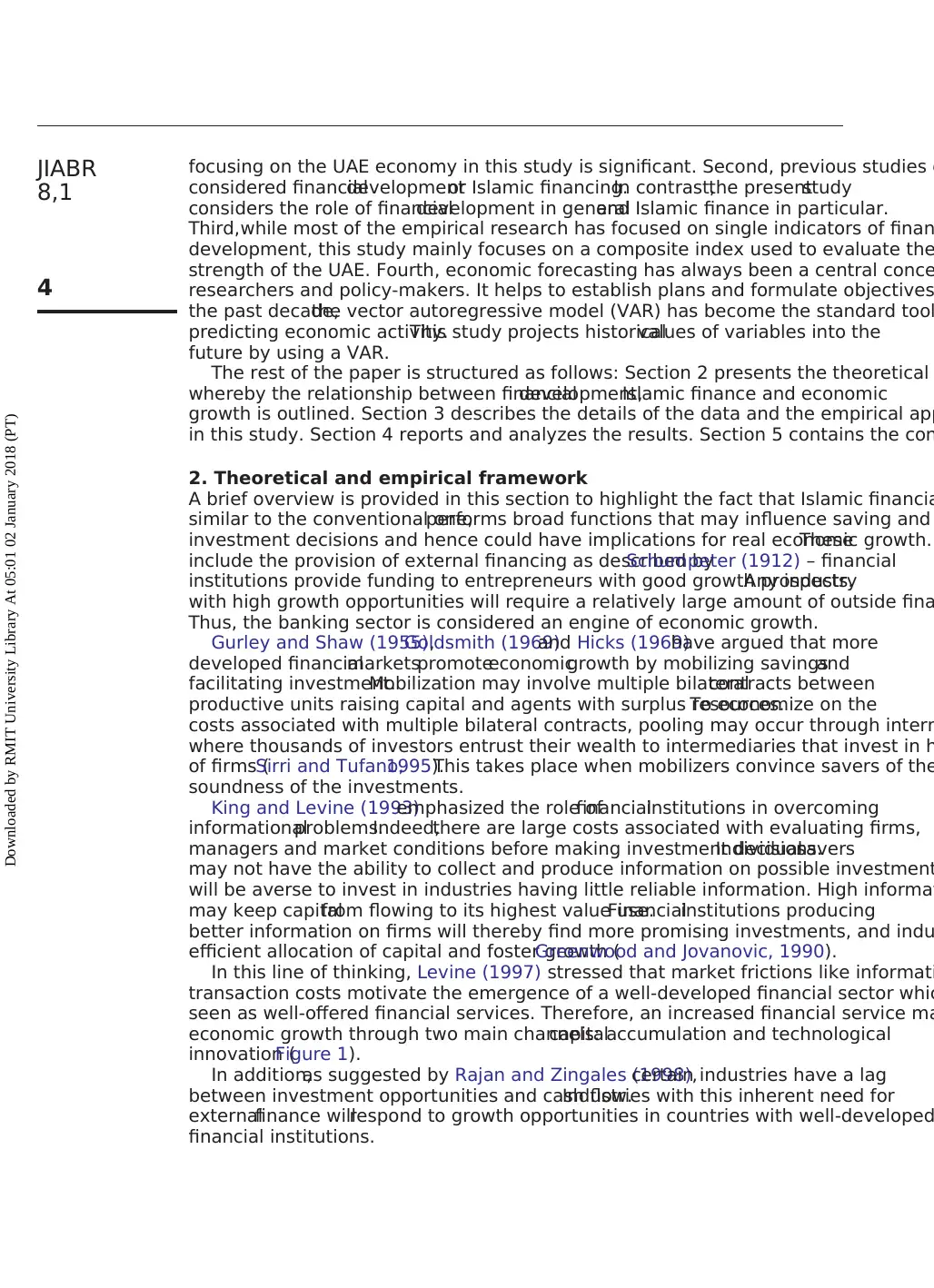
focusing on the UAE economy in this study is significant. Second, previous studies g
considered financialdevelopmentor Islamic financing.In contrast,the presentstudy
considers the role of financialdevelopment in generaland Islamic finance in particular.
Third,while most of the empirical research has focused on single indicators of finan
development, this study mainly focuses on a composite index used to evaluate the
strength of the UAE. Fourth, economic forecasting has always been a central conce
researchers and policy-makers. It helps to establish plans and formulate objectives
the past decade,the vector autoregressive model (VAR) has become the standard tool
predicting economic activity.This study projects historicalvalues of variables into the
future by using a VAR.
The rest of the paper is structured as follows: Section 2 presents the theoretical
whereby the relationship between financialdevelopment,Islamic finance and economic
growth is outlined. Section 3 describes the details of the data and the empirical app
in this study. Section 4 reports and analyzes the results. Section 5 contains the con
2. Theoretical and empirical framework
A brief overview is provided in this section to highlight the fact that Islamic financia
similar to the conventional one,performs broad functions that may influence saving and
investment decisions and hence could have implications for real economic growth.These
include the provision of external financing as described bySchumpeter (1912) – financial
institutions provide funding to entrepreneurs with good growth prospects.Any industry
with high growth opportunities will require a relatively large amount of outside fina
Thus, the banking sector is considered an engine of economic growth.
Gurley and Shaw (1955),Goldsmith (1969)and Hicks (1969)have argued that more
developed financialmarketspromoteeconomicgrowth by mobilizing savingsand
facilitating investment.Mobilization may involve multiple bilateralcontracts between
productive units raising capital and agents with surplus resources.To economize on the
costs associated with multiple bilateral contracts, pooling may occur through interm
where thousands of investors entrust their wealth to intermediaries that invest in h
of firms (Sirri and Tufano,1995).This takes place when mobilizers convince savers of the
soundness of the investments.
King and Levine (1993)emphasized the role offinancialinstitutions in overcoming
informationalproblems.Indeed,there are large costs associated with evaluating firms,
managers and market conditions before making investment decisions.Individualsavers
may not have the ability to collect and produce information on possible investment
will be averse to invest in industries having little reliable information. High informat
may keep capitalfrom flowing to its highest value use.Financialinstitutions producing
better information on firms will thereby find more promising investments, and indu
efficient allocation of capital and foster growth (Greenwood and Jovanovic, 1990).
In this line of thinking, Levine (1997) stressed that market frictions like informati
transaction costs motivate the emergence of a well-developed financial sector whic
seen as well-offered financial services. Therefore, an increased financial service ma
economic growth through two main channels:capitalaccumulation and technological
innovation (Figure 1).
In addition,as suggested by Rajan and Zingales (1998),certain industries have a lag
between investment opportunities and cash flow.Industries with this inherent need for
externalfinance willrespond to growth opportunities in countries with well-developed
financial institutions.
JIABR
8,1
4
Downloaded by RMIT University Library At 05:01 02 January 2018 (PT)
considered financialdevelopmentor Islamic financing.In contrast,the presentstudy
considers the role of financialdevelopment in generaland Islamic finance in particular.
Third,while most of the empirical research has focused on single indicators of finan
development, this study mainly focuses on a composite index used to evaluate the
strength of the UAE. Fourth, economic forecasting has always been a central conce
researchers and policy-makers. It helps to establish plans and formulate objectives
the past decade,the vector autoregressive model (VAR) has become the standard tool
predicting economic activity.This study projects historicalvalues of variables into the
future by using a VAR.
The rest of the paper is structured as follows: Section 2 presents the theoretical
whereby the relationship between financialdevelopment,Islamic finance and economic
growth is outlined. Section 3 describes the details of the data and the empirical app
in this study. Section 4 reports and analyzes the results. Section 5 contains the con
2. Theoretical and empirical framework
A brief overview is provided in this section to highlight the fact that Islamic financia
similar to the conventional one,performs broad functions that may influence saving and
investment decisions and hence could have implications for real economic growth.These
include the provision of external financing as described bySchumpeter (1912) – financial
institutions provide funding to entrepreneurs with good growth prospects.Any industry
with high growth opportunities will require a relatively large amount of outside fina
Thus, the banking sector is considered an engine of economic growth.
Gurley and Shaw (1955),Goldsmith (1969)and Hicks (1969)have argued that more
developed financialmarketspromoteeconomicgrowth by mobilizing savingsand
facilitating investment.Mobilization may involve multiple bilateralcontracts between
productive units raising capital and agents with surplus resources.To economize on the
costs associated with multiple bilateral contracts, pooling may occur through interm
where thousands of investors entrust their wealth to intermediaries that invest in h
of firms (Sirri and Tufano,1995).This takes place when mobilizers convince savers of the
soundness of the investments.
King and Levine (1993)emphasized the role offinancialinstitutions in overcoming
informationalproblems.Indeed,there are large costs associated with evaluating firms,
managers and market conditions before making investment decisions.Individualsavers
may not have the ability to collect and produce information on possible investment
will be averse to invest in industries having little reliable information. High informat
may keep capitalfrom flowing to its highest value use.Financialinstitutions producing
better information on firms will thereby find more promising investments, and indu
efficient allocation of capital and foster growth (Greenwood and Jovanovic, 1990).
In this line of thinking, Levine (1997) stressed that market frictions like informati
transaction costs motivate the emergence of a well-developed financial sector whic
seen as well-offered financial services. Therefore, an increased financial service ma
economic growth through two main channels:capitalaccumulation and technological
innovation (Figure 1).
In addition,as suggested by Rajan and Zingales (1998),certain industries have a lag
between investment opportunities and cash flow.Industries with this inherent need for
externalfinance willrespond to growth opportunities in countries with well-developed
financial institutions.
JIABR
8,1
4
Downloaded by RMIT University Library At 05:01 02 January 2018 (PT)
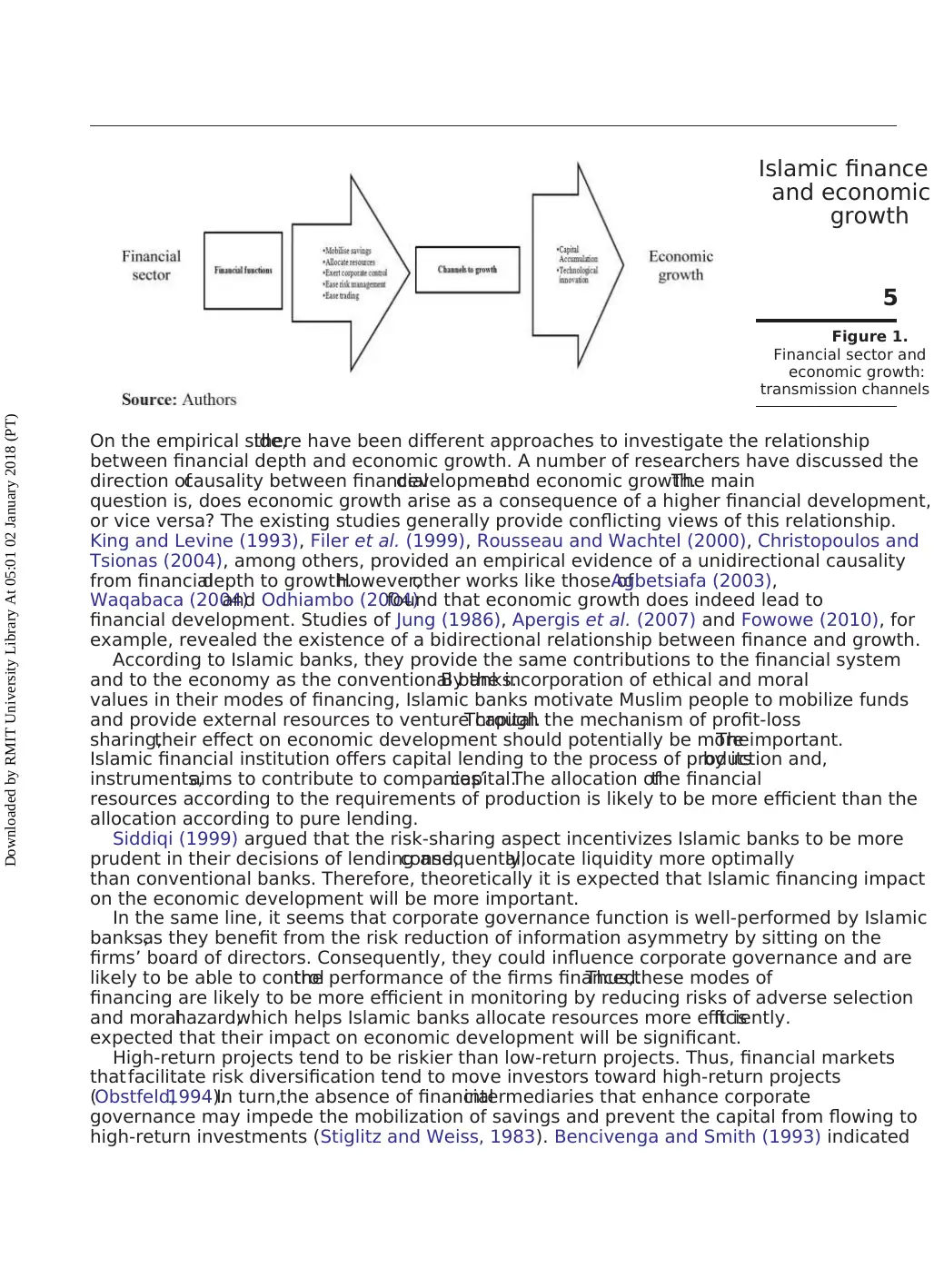
On the empirical side,there have been different approaches to investigate the relationship
between financial depth and economic growth. A number of researchers have discussed the
direction ofcausality between financialdevelopmentand economic growth.The main
question is, does economic growth arise as a consequence of a higher financial development,
or vice versa? The existing studies generally provide conflicting views of this relationship.
King and Levine (1993), Filer et al. (1999), Rousseau and Wachtel (2000), Christopoulos and
Tsionas (2004), among others, provided an empirical evidence of a unidirectional causality
from financialdepth to growth.However,other works like those ofAgbetsiafa (2003),
Waqabaca (2004)and Odhiambo (2004)found that economic growth does indeed lead to
financial development. Studies of Jung (1986), Apergis et al. (2007) and Fowowe (2010), for
example, revealed the existence of a bidirectional relationship between finance and growth.
According to Islamic banks, they provide the same contributions to the financial system
and to the economy as the conventional banks.By the incorporation of ethical and moral
values in their modes of financing, Islamic banks motivate Muslim people to mobilize funds
and provide external resources to venture capital.Through the mechanism of profit-loss
sharing,their effect on economic development should potentially be more important.The
Islamic financial institution offers capital lending to the process of production and,by its
instruments,aims to contribute to companies’capital.The allocation ofthe financial
resources according to the requirements of production is likely to be more efficient than the
allocation according to pure lending.
Siddiqi (1999) argued that the risk-sharing aspect incentivizes Islamic banks to be more
prudent in their decisions of lending and,consequently,allocate liquidity more optimally
than conventional banks. Therefore, theoretically it is expected that Islamic financing impact
on the economic development will be more important.
In the same line, it seems that corporate governance function is well-performed by Islamic
banks,as they benefit from the risk reduction of information asymmetry by sitting on the
firms’ board of directors. Consequently, they could influence corporate governance and are
likely to be able to controlthe performance of the firms financed.Thus,these modes of
financing are likely to be more efficient in monitoring by reducing risks of adverse selection
and moralhazard,which helps Islamic banks allocate resources more efficiently.It is
expected that their impact on economic development will be significant.
High-return projects tend to be riskier than low-return projects. Thus, financial markets
thatfacilitate risk diversification tend to move investors toward high-return projects
(Obstfeld,1994).In turn,the absence of financialintermediaries that enhance corporate
governance may impede the mobilization of savings and prevent the capital from flowing to
high-return investments (Stiglitz and Weiss, 1983). Bencivenga and Smith (1993) indicated
Figure 1.
Financial sector and
economic growth:
transmission channels
5
Islamic finance
and economic
growth
Downloaded by RMIT University Library At 05:01 02 January 2018 (PT)
between financial depth and economic growth. A number of researchers have discussed the
direction ofcausality between financialdevelopmentand economic growth.The main
question is, does economic growth arise as a consequence of a higher financial development,
or vice versa? The existing studies generally provide conflicting views of this relationship.
King and Levine (1993), Filer et al. (1999), Rousseau and Wachtel (2000), Christopoulos and
Tsionas (2004), among others, provided an empirical evidence of a unidirectional causality
from financialdepth to growth.However,other works like those ofAgbetsiafa (2003),
Waqabaca (2004)and Odhiambo (2004)found that economic growth does indeed lead to
financial development. Studies of Jung (1986), Apergis et al. (2007) and Fowowe (2010), for
example, revealed the existence of a bidirectional relationship between finance and growth.
According to Islamic banks, they provide the same contributions to the financial system
and to the economy as the conventional banks.By the incorporation of ethical and moral
values in their modes of financing, Islamic banks motivate Muslim people to mobilize funds
and provide external resources to venture capital.Through the mechanism of profit-loss
sharing,their effect on economic development should potentially be more important.The
Islamic financial institution offers capital lending to the process of production and,by its
instruments,aims to contribute to companies’capital.The allocation ofthe financial
resources according to the requirements of production is likely to be more efficient than the
allocation according to pure lending.
Siddiqi (1999) argued that the risk-sharing aspect incentivizes Islamic banks to be more
prudent in their decisions of lending and,consequently,allocate liquidity more optimally
than conventional banks. Therefore, theoretically it is expected that Islamic financing impact
on the economic development will be more important.
In the same line, it seems that corporate governance function is well-performed by Islamic
banks,as they benefit from the risk reduction of information asymmetry by sitting on the
firms’ board of directors. Consequently, they could influence corporate governance and are
likely to be able to controlthe performance of the firms financed.Thus,these modes of
financing are likely to be more efficient in monitoring by reducing risks of adverse selection
and moralhazard,which helps Islamic banks allocate resources more efficiently.It is
expected that their impact on economic development will be significant.
High-return projects tend to be riskier than low-return projects. Thus, financial markets
thatfacilitate risk diversification tend to move investors toward high-return projects
(Obstfeld,1994).In turn,the absence of financialintermediaries that enhance corporate
governance may impede the mobilization of savings and prevent the capital from flowing to
high-return investments (Stiglitz and Weiss, 1983). Bencivenga and Smith (1993) indicated
Figure 1.
Financial sector and
economic growth:
transmission channels
5
Islamic finance
and economic
growth
Downloaded by RMIT University Library At 05:01 02 January 2018 (PT)
⊘ This is a preview!⊘
Do you want full access?
Subscribe today to unlock all pages.

Trusted by 1+ million students worldwide
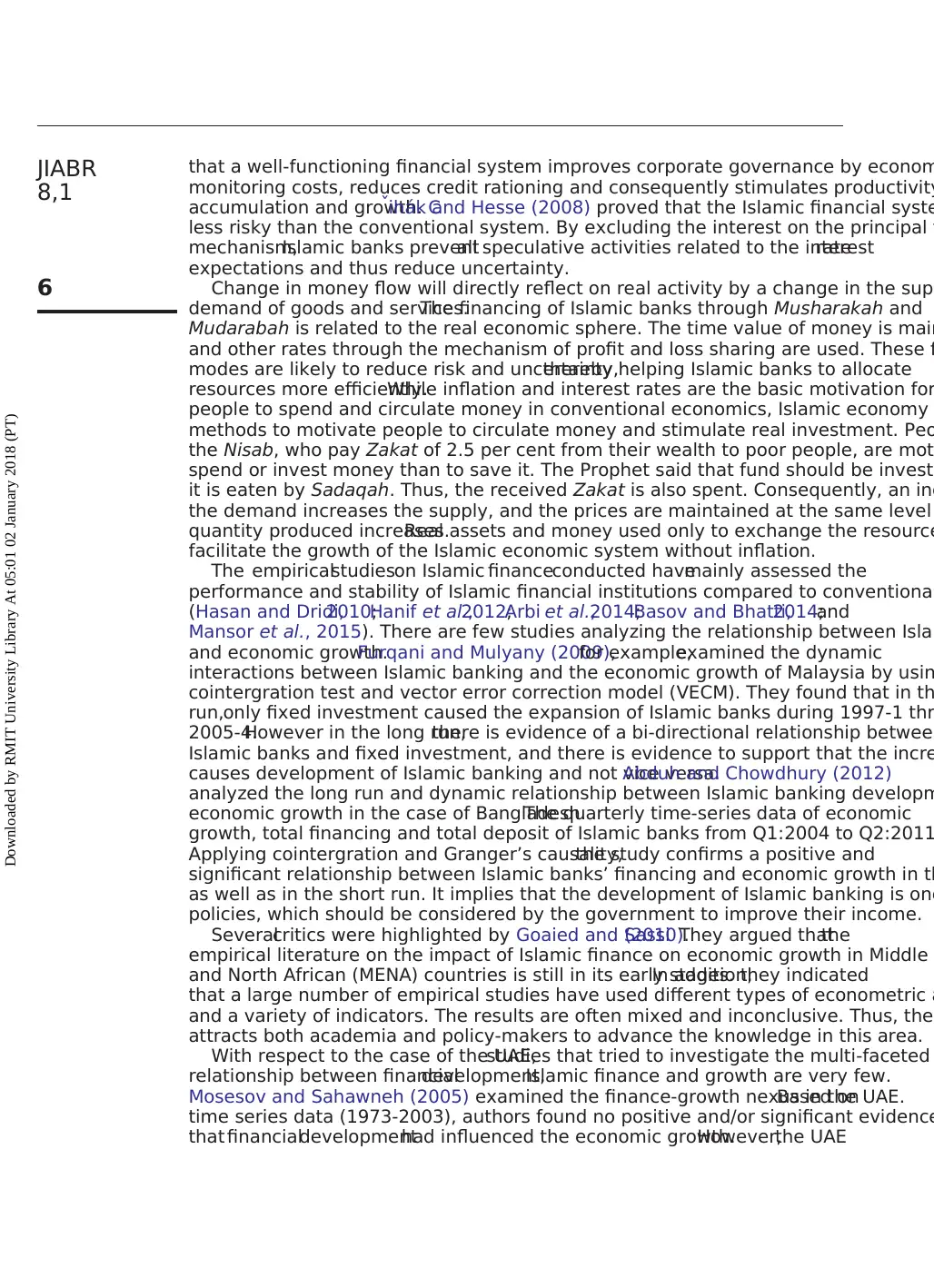
that a well-functioning financial system improves corporate governance by econom
monitoring costs, reduces credit rationing and consequently stimulates productivity
accumulation and growth. Cˇihák and Hesse (2008) proved that the Islamic financial syste
less risky than the conventional system. By excluding the interest on the principal f
mechanism,Islamic banks preventall speculative activities related to the interestrate
expectations and thus reduce uncertainty.
Change in money flow will directly reflect on real activity by a change in the supp
demand of goods and services.The financing of Islamic banks through Musharakah and
Mudarabah is related to the real economic sphere. The time value of money is main
and other rates through the mechanism of profit and loss sharing are used. These fi
modes are likely to reduce risk and uncertainty,thereby helping Islamic banks to allocate
resources more efficiently.While inflation and interest rates are the basic motivation for
people to spend and circulate money in conventional economics, Islamic economy
methods to motivate people to circulate money and stimulate real investment. Peo
the Nisab, who pay Zakat of 2.5 per cent from their wealth to poor people, are mot
spend or invest money than to save it. The Prophet said that fund should be investe
it is eaten by Sadaqah. Thus, the received Zakat is also spent. Consequently, an inc
the demand increases the supply, and the prices are maintained at the same level
quantity produced increases.Real assets and money used only to exchange the resource
facilitate the growth of the Islamic economic system without inflation.
The empiricalstudieson Islamic financeconducted havemainly assessed the
performance and stability of Islamic financial institutions compared to conventional
(Hasan and Dridi,2010;Hanif et al.,2012;Arbi et al.,2014;Basov and Bhatti,2014;and
Mansor et al., 2015). There are few studies analyzing the relationship between Islam
and economic growth.Furqani and Mulyany (2009),for example,examined the dynamic
interactions between Islamic banking and the economic growth of Malaysia by usin
cointergration test and vector error correction model (VECM). They found that in th
run,only fixed investment caused the expansion of Islamic banks during 1997-1 thr
2005-4.However in the long run,there is evidence of a bi-directional relationship between
Islamic banks and fixed investment, and there is evidence to support that the incre
causes development of Islamic banking and not vice versa.Abduh and Chowdhury (2012)
analyzed the long run and dynamic relationship between Islamic banking developm
economic growth in the case of Bangladesh.The quarterly time-series data of economic
growth, total financing and total deposit of Islamic banks from Q1:2004 to Q2:2011
Applying cointergration and Granger’s causality,the study confirms a positive and
significant relationship between Islamic banks’ financing and economic growth in th
as well as in the short run. It implies that the development of Islamic banking is one
policies, which should be considered by the government to improve their income.
Severalcritics were highlighted by Goaied and Sassi(2010).They argued thatthe
empirical literature on the impact of Islamic finance on economic growth in Middle
and North African (MENA) countries is still in its early stages.In addition,they indicated
that a large number of empirical studies have used different types of econometric a
and a variety of indicators. The results are often mixed and inconclusive. Thus, the
attracts both academia and policy-makers to advance the knowledge in this area.
With respect to the case of the UAE,studies that tried to investigate the multi-faceted
relationship between financialdevelopment,Islamic finance and growth are very few.
Mosesov and Sahawneh (2005) examined the finance-growth nexus in the UAE.Based on
time series data (1973-2003), authors found no positive and/or significant evidence
that financialdevelopmenthad influenced the economic growth.However,the UAE
JIABR
8,1
6
Downloaded by RMIT University Library At 05:01 02 January 2018 (PT)
monitoring costs, reduces credit rationing and consequently stimulates productivity
accumulation and growth. Cˇihák and Hesse (2008) proved that the Islamic financial syste
less risky than the conventional system. By excluding the interest on the principal f
mechanism,Islamic banks preventall speculative activities related to the interestrate
expectations and thus reduce uncertainty.
Change in money flow will directly reflect on real activity by a change in the supp
demand of goods and services.The financing of Islamic banks through Musharakah and
Mudarabah is related to the real economic sphere. The time value of money is main
and other rates through the mechanism of profit and loss sharing are used. These fi
modes are likely to reduce risk and uncertainty,thereby helping Islamic banks to allocate
resources more efficiently.While inflation and interest rates are the basic motivation for
people to spend and circulate money in conventional economics, Islamic economy
methods to motivate people to circulate money and stimulate real investment. Peo
the Nisab, who pay Zakat of 2.5 per cent from their wealth to poor people, are mot
spend or invest money than to save it. The Prophet said that fund should be investe
it is eaten by Sadaqah. Thus, the received Zakat is also spent. Consequently, an inc
the demand increases the supply, and the prices are maintained at the same level
quantity produced increases.Real assets and money used only to exchange the resource
facilitate the growth of the Islamic economic system without inflation.
The empiricalstudieson Islamic financeconducted havemainly assessed the
performance and stability of Islamic financial institutions compared to conventional
(Hasan and Dridi,2010;Hanif et al.,2012;Arbi et al.,2014;Basov and Bhatti,2014;and
Mansor et al., 2015). There are few studies analyzing the relationship between Islam
and economic growth.Furqani and Mulyany (2009),for example,examined the dynamic
interactions between Islamic banking and the economic growth of Malaysia by usin
cointergration test and vector error correction model (VECM). They found that in th
run,only fixed investment caused the expansion of Islamic banks during 1997-1 thr
2005-4.However in the long run,there is evidence of a bi-directional relationship between
Islamic banks and fixed investment, and there is evidence to support that the incre
causes development of Islamic banking and not vice versa.Abduh and Chowdhury (2012)
analyzed the long run and dynamic relationship between Islamic banking developm
economic growth in the case of Bangladesh.The quarterly time-series data of economic
growth, total financing and total deposit of Islamic banks from Q1:2004 to Q2:2011
Applying cointergration and Granger’s causality,the study confirms a positive and
significant relationship between Islamic banks’ financing and economic growth in th
as well as in the short run. It implies that the development of Islamic banking is one
policies, which should be considered by the government to improve their income.
Severalcritics were highlighted by Goaied and Sassi(2010).They argued thatthe
empirical literature on the impact of Islamic finance on economic growth in Middle
and North African (MENA) countries is still in its early stages.In addition,they indicated
that a large number of empirical studies have used different types of econometric a
and a variety of indicators. The results are often mixed and inconclusive. Thus, the
attracts both academia and policy-makers to advance the knowledge in this area.
With respect to the case of the UAE,studies that tried to investigate the multi-faceted
relationship between financialdevelopment,Islamic finance and growth are very few.
Mosesov and Sahawneh (2005) examined the finance-growth nexus in the UAE.Based on
time series data (1973-2003), authors found no positive and/or significant evidence
that financialdevelopmenthad influenced the economic growth.However,the UAE
JIABR
8,1
6
Downloaded by RMIT University Library At 05:01 02 January 2018 (PT)
Paraphrase This Document
Need a fresh take? Get an instant paraphrase of this document with our AI Paraphraser
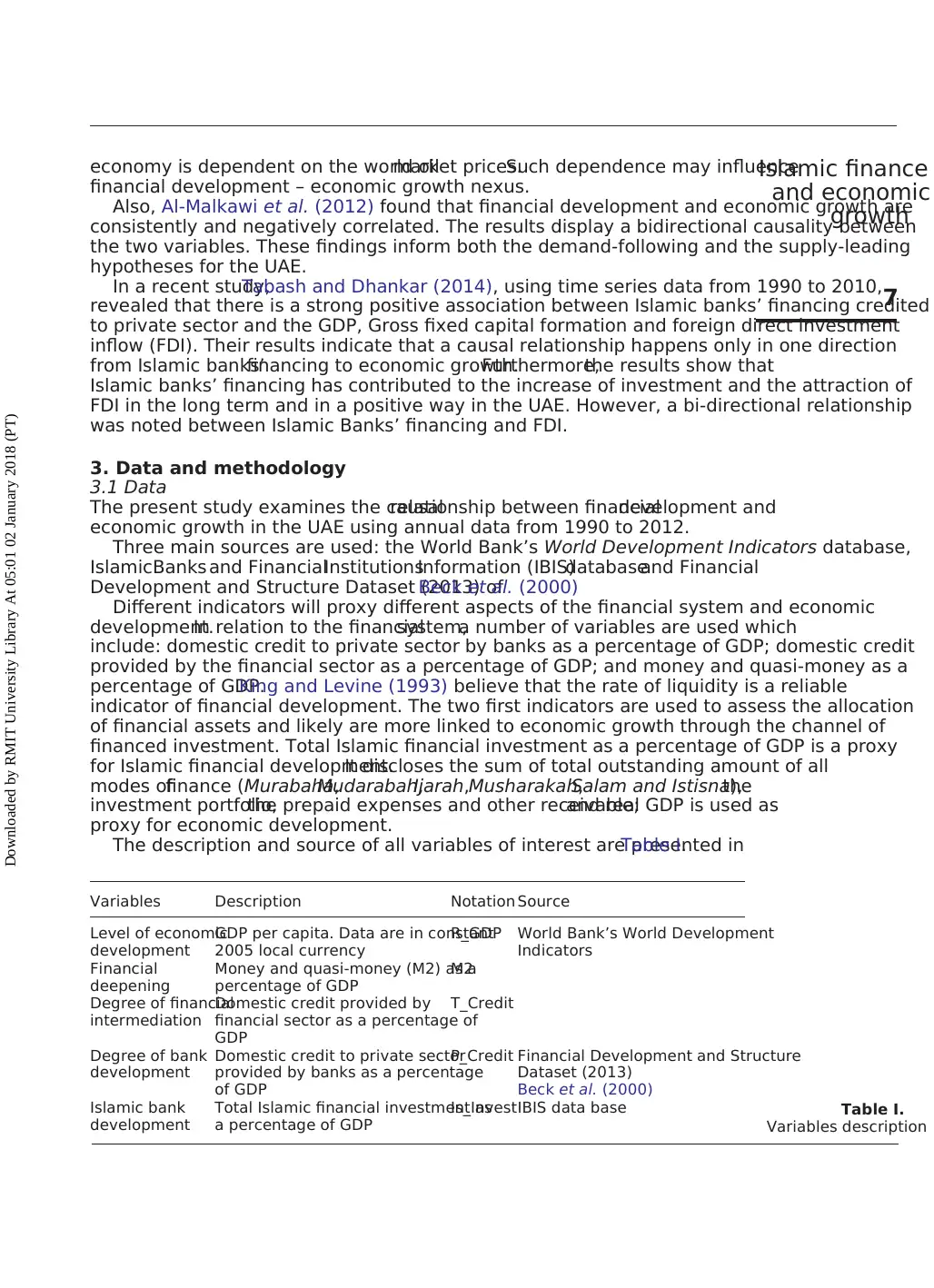
economy is dependent on the world oilmarket prices.Such dependence may influence
financial development – economic growth nexus.
Also, Al-Malkawi et al. (2012) found that financial development and economic growth are
consistently and negatively correlated. The results display a bidirectional causality between
the two variables. These findings inform both the demand-following and the supply-leading
hypotheses for the UAE.
In a recent study,Tabash and Dhankar (2014), using time series data from 1990 to 2010,
revealed that there is a strong positive association between Islamic banks’ financing credited
to private sector and the GDP, Gross fixed capital formation and foreign direct investment
inflow (FDI). Their results indicate that a causal relationship happens only in one direction
from Islamic banks’financing to economic growth.Furthermore,the results show that
Islamic banks’ financing has contributed to the increase of investment and the attraction of
FDI in the long term and in a positive way in the UAE. However, a bi-directional relationship
was noted between Islamic Banks’ financing and FDI.
3. Data and methodology
3.1 Data
The present study examines the causalrelationship between financialdevelopment and
economic growth in the UAE using annual data from 1990 to 2012.
Three main sources are used: the World Bank’s World Development Indicators database,
IslamicBanks and FinancialInstitutionsInformation (IBIS)databaseand Financial
Development and Structure Dataset (2013) ofBeck et al. (2000)
Different indicators will proxy different aspects of the financial system and economic
development.In relation to the financialsystem,a number of variables are used which
include: domestic credit to private sector by banks as a percentage of GDP; domestic credit
provided by the financial sector as a percentage of GDP; and money and quasi-money as a
percentage of GDP.King and Levine (1993) believe that the rate of liquidity is a reliable
indicator of financial development. The two first indicators are used to assess the allocation
of financial assets and likely are more linked to economic growth through the channel of
financed investment. Total Islamic financial investment as a percentage of GDP is a proxy
for Islamic financial development.It discloses the sum of total outstanding amount of all
modes offinance (Murabaha,Mudarabah,Ijarah,Musharakah,Salam and Istisna),the
investment portfolio,the prepaid expenses and other receivable;and real GDP is used as
proxy for economic development.
The description and source of all variables of interest are presented inTable I.
Table I.
Variables description
Variables Description Notation Source
Level of economic
development
GDP per capita. Data are in constant
2005 local currency
R_GDP World Bank’s World Development
Indicators
Financial
deepening
Money and quasi-money (M2) as a
percentage of GDP
M2
Degree of financial
intermediation
Domestic credit provided by
financial sector as a percentage of
GDP
T_Credit
Degree of bank
development
Domestic credit to private sector
provided by banks as a percentage
of GDP
P_Credit Financial Development and Structure
Dataset (2013)
Beck et al. (2000)
Islamic bank
development
Total Islamic financial investment as
a percentage of GDP
Is_InvestIBIS data base
7
Islamic finance
and economic
growth
Downloaded by RMIT University Library At 05:01 02 January 2018 (PT)
financial development – economic growth nexus.
Also, Al-Malkawi et al. (2012) found that financial development and economic growth are
consistently and negatively correlated. The results display a bidirectional causality between
the two variables. These findings inform both the demand-following and the supply-leading
hypotheses for the UAE.
In a recent study,Tabash and Dhankar (2014), using time series data from 1990 to 2010,
revealed that there is a strong positive association between Islamic banks’ financing credited
to private sector and the GDP, Gross fixed capital formation and foreign direct investment
inflow (FDI). Their results indicate that a causal relationship happens only in one direction
from Islamic banks’financing to economic growth.Furthermore,the results show that
Islamic banks’ financing has contributed to the increase of investment and the attraction of
FDI in the long term and in a positive way in the UAE. However, a bi-directional relationship
was noted between Islamic Banks’ financing and FDI.
3. Data and methodology
3.1 Data
The present study examines the causalrelationship between financialdevelopment and
economic growth in the UAE using annual data from 1990 to 2012.
Three main sources are used: the World Bank’s World Development Indicators database,
IslamicBanks and FinancialInstitutionsInformation (IBIS)databaseand Financial
Development and Structure Dataset (2013) ofBeck et al. (2000)
Different indicators will proxy different aspects of the financial system and economic
development.In relation to the financialsystem,a number of variables are used which
include: domestic credit to private sector by banks as a percentage of GDP; domestic credit
provided by the financial sector as a percentage of GDP; and money and quasi-money as a
percentage of GDP.King and Levine (1993) believe that the rate of liquidity is a reliable
indicator of financial development. The two first indicators are used to assess the allocation
of financial assets and likely are more linked to economic growth through the channel of
financed investment. Total Islamic financial investment as a percentage of GDP is a proxy
for Islamic financial development.It discloses the sum of total outstanding amount of all
modes offinance (Murabaha,Mudarabah,Ijarah,Musharakah,Salam and Istisna),the
investment portfolio,the prepaid expenses and other receivable;and real GDP is used as
proxy for economic development.
The description and source of all variables of interest are presented inTable I.
Table I.
Variables description
Variables Description Notation Source
Level of economic
development
GDP per capita. Data are in constant
2005 local currency
R_GDP World Bank’s World Development
Indicators
Financial
deepening
Money and quasi-money (M2) as a
percentage of GDP
M2
Degree of financial
intermediation
Domestic credit provided by
financial sector as a percentage of
GDP
T_Credit
Degree of bank
development
Domestic credit to private sector
provided by banks as a percentage
of GDP
P_Credit Financial Development and Structure
Dataset (2013)
Beck et al. (2000)
Islamic bank
development
Total Islamic financial investment as
a percentage of GDP
Is_InvestIBIS data base
7
Islamic finance
and economic
growth
Downloaded by RMIT University Library At 05:01 02 January 2018 (PT)

3.2 Methodology
The methodology used to assess the relationship between financial development,Islamic
finance and economic growth is divided in three steps.First,to assess the effect of the
different dimensions included in the concept of financial development, the authors
a composite indicator determined with the non-parametric approach:data envelopment
analysis (DEA).This approach uses linear programming tools and defined a best pract
frontier that serves as a benchmark for estimating the performance of a given set o
Financial sector performance is represented by the distance to the best practice fro
weights for partial indicators are endogenously calculated in such a way that the di
minimized for every unit. More precisely, the authors present a variant of the DEA m
radial model without inputs (Lovell and Pastor, 1999). This approach is supposed to be ab
to direct all the partial indicators toward their maximum values. It is a DEA model d
toward the outputs,and only one input is a dummy equal to the unit for all the studied
decision making units (DMU)[1]. The purpose is to maximize the composite indicator give
the constraint of the partial indicators availability[2]. The DEA model is thus the fol
Max 兺i
vi Xi0 ⫽ CI 0
ST: 兺r
兺rYr0 ⫽ 1
兺i
vi Xij ⫺ 兺r
兺rYrj ⱕ 0 ∀j ⫽ 1… …N Normalization constraint
With N: number of studied DMU.
vi ⱖ 0 ∀i ⫽ 1… …p Non-negativity constraint
兺r ⱖ 0 ∀r ⫽ 1… …q
(1)
Vrj ⫽ 兺rYrj/ 兺 r⫽1
q 兺rYrj is the contribution of each partial indicator, as presented in the pre
section in the construction of composite indicator;
DMUj consumesamountXij of input i and producesamountY rj of outputr
(sub-indicators);
CI0 is a composite indicator (CI) for a given country. The authors obtain 0 ⱕ CI ⱕ 1
(expressed as a percentage) for each country j. A score close to 100 indicates a bet
financial sector performance;
i means sub-indicators;
Xi0 equal to unit;
vi is the weight of the ith indicator:The highest relative weights are assigned to the
sub-indicators for which the country j achieves the best relative financial sector per
in comparison to the other countries. The weights are not fixed a priori; the only re
in the formulation above is that they should be non-negative, which implies that th
non-decreasing function of the sub-indicators (non-negativity constraint).In the financial
composite index case, each sub-indicator/output i has the following interpretation:ij ⬎
Y ik, then country j has a more developed financial market than country k. The norm
constraint means that no country in the sample can achieve a value that is greater
under these weights.
The estimation of the composite indicators was carried out with the software EM
The second step involved the use of a bivariate vector autoregressive model (bV
analyze the long-term relationships between financial deepening and economic gro
first level of the bVAR study is to determine whether the series are stationary or noIn a
model, to ensure a correct evaluation, time series should be separated from all effe
JIABR
8,1
8
Downloaded by RMIT University Library At 05:01 02 January 2018 (PT)
The methodology used to assess the relationship between financial development,Islamic
finance and economic growth is divided in three steps.First,to assess the effect of the
different dimensions included in the concept of financial development, the authors
a composite indicator determined with the non-parametric approach:data envelopment
analysis (DEA).This approach uses linear programming tools and defined a best pract
frontier that serves as a benchmark for estimating the performance of a given set o
Financial sector performance is represented by the distance to the best practice fro
weights for partial indicators are endogenously calculated in such a way that the di
minimized for every unit. More precisely, the authors present a variant of the DEA m
radial model without inputs (Lovell and Pastor, 1999). This approach is supposed to be ab
to direct all the partial indicators toward their maximum values. It is a DEA model d
toward the outputs,and only one input is a dummy equal to the unit for all the studied
decision making units (DMU)[1]. The purpose is to maximize the composite indicator give
the constraint of the partial indicators availability[2]. The DEA model is thus the fol
Max 兺i
vi Xi0 ⫽ CI 0
ST: 兺r
兺rYr0 ⫽ 1
兺i
vi Xij ⫺ 兺r
兺rYrj ⱕ 0 ∀j ⫽ 1… …N Normalization constraint
With N: number of studied DMU.
vi ⱖ 0 ∀i ⫽ 1… …p Non-negativity constraint
兺r ⱖ 0 ∀r ⫽ 1… …q
(1)
Vrj ⫽ 兺rYrj/ 兺 r⫽1
q 兺rYrj is the contribution of each partial indicator, as presented in the pre
section in the construction of composite indicator;
DMUj consumesamountXij of input i and producesamountY rj of outputr
(sub-indicators);
CI0 is a composite indicator (CI) for a given country. The authors obtain 0 ⱕ CI ⱕ 1
(expressed as a percentage) for each country j. A score close to 100 indicates a bet
financial sector performance;
i means sub-indicators;
Xi0 equal to unit;
vi is the weight of the ith indicator:The highest relative weights are assigned to the
sub-indicators for which the country j achieves the best relative financial sector per
in comparison to the other countries. The weights are not fixed a priori; the only re
in the formulation above is that they should be non-negative, which implies that th
non-decreasing function of the sub-indicators (non-negativity constraint).In the financial
composite index case, each sub-indicator/output i has the following interpretation:ij ⬎
Y ik, then country j has a more developed financial market than country k. The norm
constraint means that no country in the sample can achieve a value that is greater
under these weights.
The estimation of the composite indicators was carried out with the software EM
The second step involved the use of a bivariate vector autoregressive model (bV
analyze the long-term relationships between financial deepening and economic gro
first level of the bVAR study is to determine whether the series are stationary or noIn a
model, to ensure a correct evaluation, time series should be separated from all effe
JIABR
8,1
8
Downloaded by RMIT University Library At 05:01 02 January 2018 (PT)
⊘ This is a preview!⊘
Do you want full access?
Subscribe today to unlock all pages.

Trusted by 1+ million students worldwide
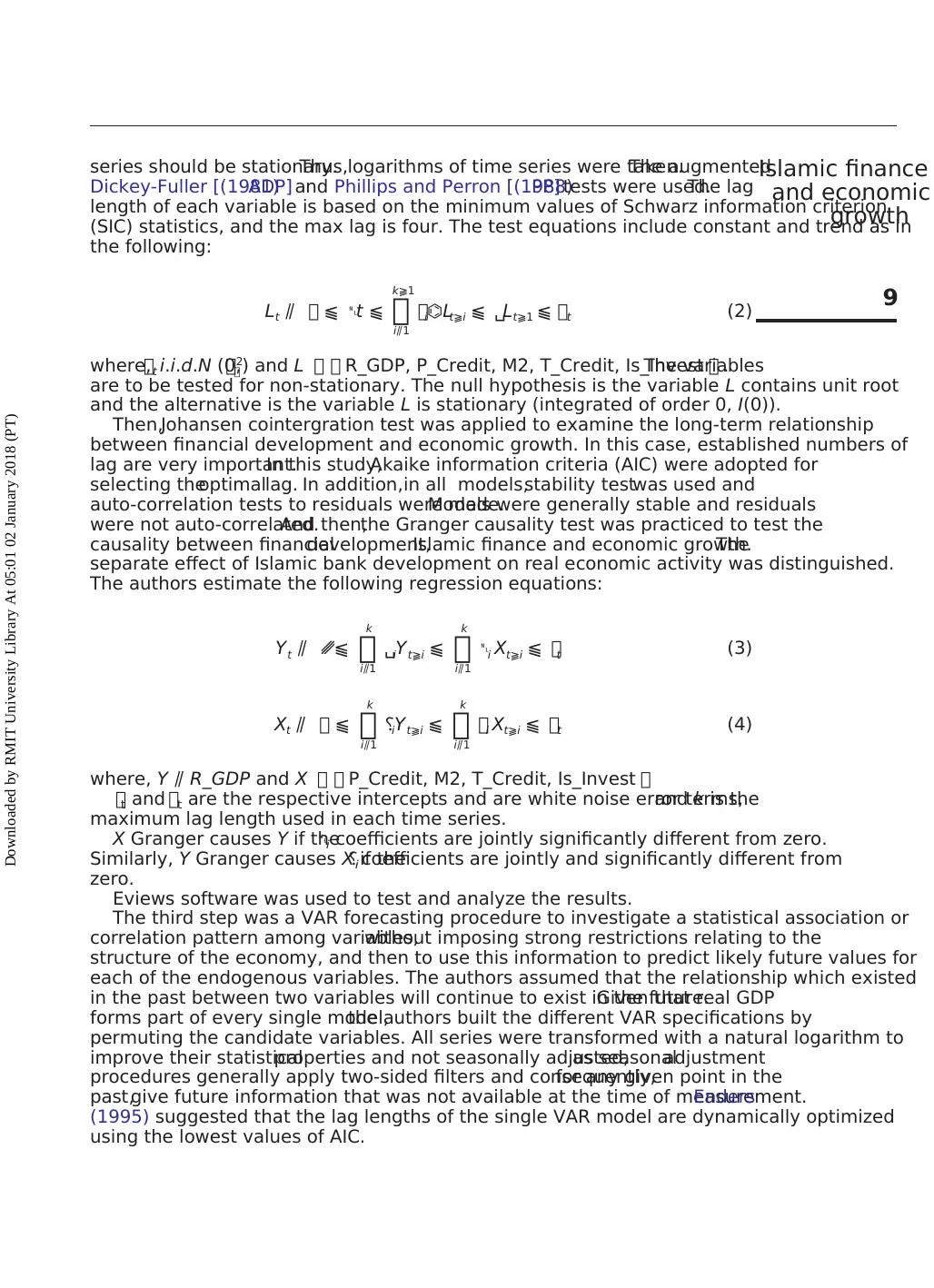
series should be stationary.Thus,logarithms of time series were taken.The augmented
Dickey-Fuller [(1981)ADP] and Phillips and Perron [(1988)PP] tests were used.The lag
length of each variable is based on the minimum values of Schwarz information criterion
(SIC) statistics, and the max lag is four. The test equations include constant and trend as in
the following:
Lt ⫽ 兺 ⫹ t ⫹ 兺i⫽1
k⫺1
兺i⌬Lt⫺i ⫹ ␣Lt⫺1 ⫹ 兺t (2)
where,兺t i.i.d.N (0,兺兺
2) and L 兺 兺 R_GDP, P_Credit, M2, T_Credit, Is_Invest 兺 .The variables
are to be tested for non-stationary. The null hypothesis is the variable L contains unit root
and the alternative is the variable L is stationary (integrated of order 0, I(0)).
Then,Johansen cointergration test was applied to examine the long-term relationship
between financial development and economic growth. In this case, established numbers of
lag are very important.In this study,Akaike information criteria (AIC) were adopted for
selecting theoptimallag. In addition,in all models,stability testwas used and
auto-correlation tests to residuals were made.Models were generally stable and residuals
were not auto-correlated.And then,the Granger causality test was practiced to test the
causality between financialdevelopment,Islamic finance and economic growth.The
separate effect of Islamic bank development on real economic activity was distinguished.
The authors estimate the following regression equations:
Yt ⫽ ␥⫹ 兺i⫽1
k
␣iYt⫺i ⫹ 兺i⫽1
k
i Xt⫺i ⫹ 兺t (3)
Xt ⫽ 兺 ⫹ 兺i⫽1
k
␦iYt⫺i ⫹ 兺i⫽1
k
兺i Xt⫺i ⫹ 兺t (4)
where, Y ⫽ R_GDP and X 兺 兺 P_Credit, M2, T_Credit, Is_Invest 兺
兺t and 兺t are the respective intercepts and are white noise error terms,and k is the
maximum lag length used in each time series.
X Granger causes Y if thei coefficients are jointly significantly different from zero.
Similarly, Y Granger causes X if the␦i coefficients are jointly and significantly different from
zero.
Eviews software was used to test and analyze the results.
The third step was a VAR forecasting procedure to investigate a statistical association or
correlation pattern among variables,without imposing strong restrictions relating to the
structure of the economy, and then to use this information to predict likely future values for
each of the endogenous variables. The authors assumed that the relationship which existed
in the past between two variables will continue to exist in the future.Given that real GDP
forms part of every single model,the authors built the different VAR specifications by
permuting the candidate variables. All series were transformed with a natural logarithm to
improve their statisticalproperties and not seasonally adjusted,as seasonaladjustment
procedures generally apply two-sided filters and consequently,for any given point in the
past,give future information that was not available at the time of measurement.Enders
(1995) suggested that the lag lengths of the single VAR model are dynamically optimized
using the lowest values of AIC.
9
Islamic finance
and economic
growth
Downloaded by RMIT University Library At 05:01 02 January 2018 (PT)
Dickey-Fuller [(1981)ADP] and Phillips and Perron [(1988)PP] tests were used.The lag
length of each variable is based on the minimum values of Schwarz information criterion
(SIC) statistics, and the max lag is four. The test equations include constant and trend as in
the following:
Lt ⫽ 兺 ⫹ t ⫹ 兺i⫽1
k⫺1
兺i⌬Lt⫺i ⫹ ␣Lt⫺1 ⫹ 兺t (2)
where,兺t i.i.d.N (0,兺兺
2) and L 兺 兺 R_GDP, P_Credit, M2, T_Credit, Is_Invest 兺 .The variables
are to be tested for non-stationary. The null hypothesis is the variable L contains unit root
and the alternative is the variable L is stationary (integrated of order 0, I(0)).
Then,Johansen cointergration test was applied to examine the long-term relationship
between financial development and economic growth. In this case, established numbers of
lag are very important.In this study,Akaike information criteria (AIC) were adopted for
selecting theoptimallag. In addition,in all models,stability testwas used and
auto-correlation tests to residuals were made.Models were generally stable and residuals
were not auto-correlated.And then,the Granger causality test was practiced to test the
causality between financialdevelopment,Islamic finance and economic growth.The
separate effect of Islamic bank development on real economic activity was distinguished.
The authors estimate the following regression equations:
Yt ⫽ ␥⫹ 兺i⫽1
k
␣iYt⫺i ⫹ 兺i⫽1
k
i Xt⫺i ⫹ 兺t (3)
Xt ⫽ 兺 ⫹ 兺i⫽1
k
␦iYt⫺i ⫹ 兺i⫽1
k
兺i Xt⫺i ⫹ 兺t (4)
where, Y ⫽ R_GDP and X 兺 兺 P_Credit, M2, T_Credit, Is_Invest 兺
兺t and 兺t are the respective intercepts and are white noise error terms,and k is the
maximum lag length used in each time series.
X Granger causes Y if thei coefficients are jointly significantly different from zero.
Similarly, Y Granger causes X if the␦i coefficients are jointly and significantly different from
zero.
Eviews software was used to test and analyze the results.
The third step was a VAR forecasting procedure to investigate a statistical association or
correlation pattern among variables,without imposing strong restrictions relating to the
structure of the economy, and then to use this information to predict likely future values for
each of the endogenous variables. The authors assumed that the relationship which existed
in the past between two variables will continue to exist in the future.Given that real GDP
forms part of every single model,the authors built the different VAR specifications by
permuting the candidate variables. All series were transformed with a natural logarithm to
improve their statisticalproperties and not seasonally adjusted,as seasonaladjustment
procedures generally apply two-sided filters and consequently,for any given point in the
past,give future information that was not available at the time of measurement.Enders
(1995) suggested that the lag lengths of the single VAR model are dynamically optimized
using the lowest values of AIC.
9
Islamic finance
and economic
growth
Downloaded by RMIT University Library At 05:01 02 January 2018 (PT)
Paraphrase This Document
Need a fresh take? Get an instant paraphrase of this document with our AI Paraphraser
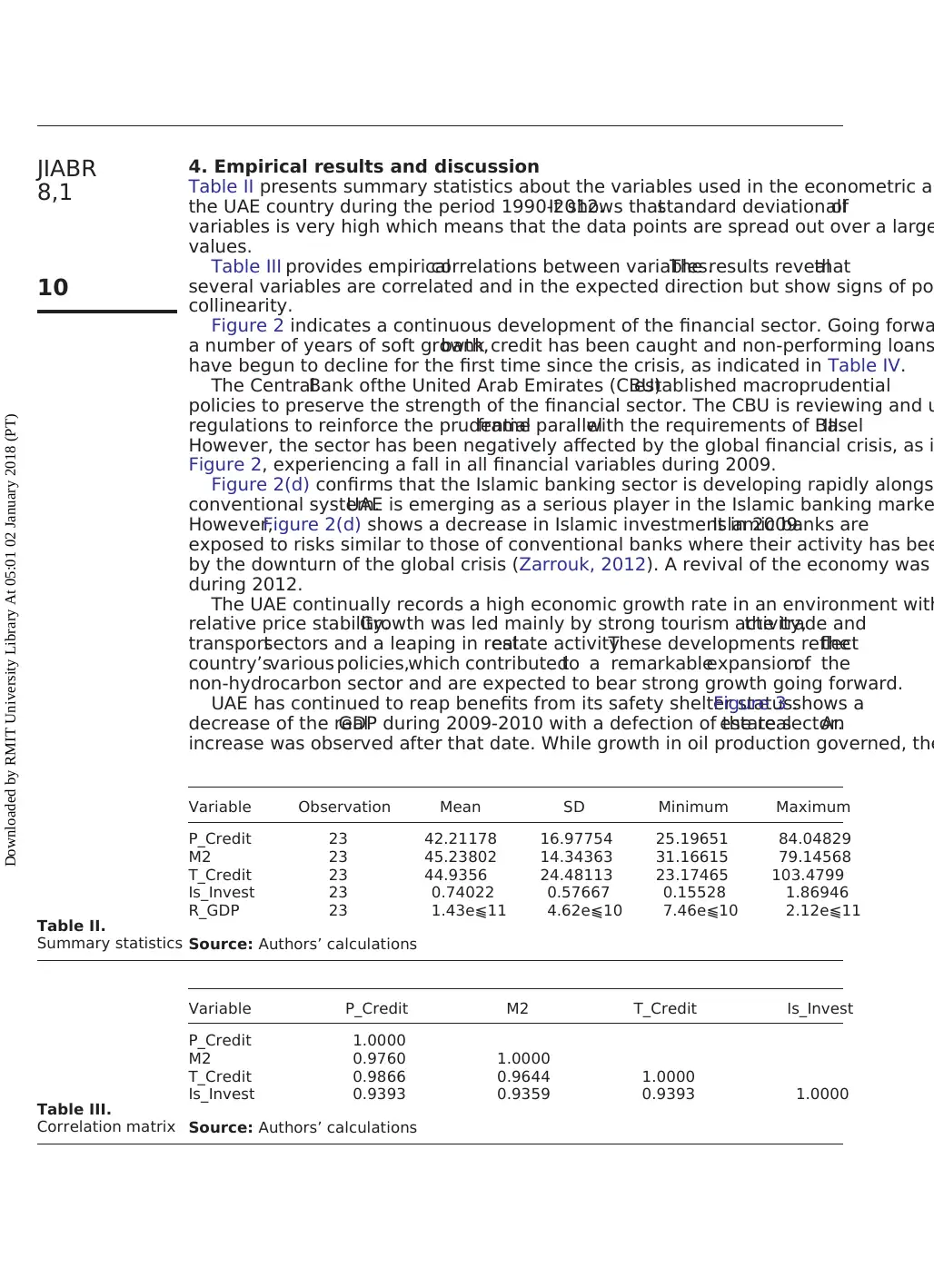
4. Empirical results and discussion
Table II presents summary statistics about the variables used in the econometric an
the UAE country during the period 1990-2012.It shows thatstandard deviation ofall
variables is very high which means that the data points are spread out over a large
values.
Table III provides empiricalcorrelations between variables.The results revealthat
several variables are correlated and in the expected direction but show signs of po
collinearity.
Figure 2 indicates a continuous development of the financial sector. Going forwa
a number of years of soft growth,bank credit has been caught and non-performing loans
have begun to decline for the first time since the crisis, as indicated in Table IV.
The CentralBank ofthe United Arab Emirates (CBU)established macroprudential
policies to preserve the strength of the financial sector. The CBU is reviewing and u
regulations to reinforce the prudentialframe parallelwith the requirements of BaselIII.
However, the sector has been negatively affected by the global financial crisis, as i
Figure 2, experiencing a fall in all financial variables during 2009.
Figure 2(d) confirms that the Islamic banking sector is developing rapidly alongs
conventional system.UAE is emerging as a serious player in the Islamic banking marke
However,Figure 2(d) shows a decrease in Islamic investment in 2009.Islamic banks are
exposed to risks similar to those of conventional banks where their activity has bee
by the downturn of the global crisis (Zarrouk, 2012). A revival of the economy was
during 2012.
The UAE continually records a high economic growth rate in an environment with
relative price stability.Growth was led mainly by strong tourism activity,the trade and
transportsectors and a leaping in realestate activity.These developments reflectthe
country’svarious policies,which contributedto a remarkableexpansionof the
non-hydrocarbon sector and are expected to bear strong growth going forward.
UAE has continued to reap benefits from its safety shelter status.Figure 3 shows a
decrease of the realGDP during 2009-2010 with a defection of the realestate sector.An
increase was observed after that date. While growth in oil production governed, the
Table II.
Summary statistics
Variable Observation Mean SD Minimum Maximum
P_Credit 23 42.21178 16.97754 25.19651 84.04829
M2 23 45.23802 14.34363 31.16615 79.14568
T_Credit 23 44.9356 24.48113 23.17465 103.4799
Is_Invest 23 0.74022 0.57667 0.15528 1.86946
R_GDP 23 1.43e⫹11 4.62e⫹10 7.46e⫹10 2.12e⫹11
Source: Authors’ calculations
Table III.
Correlation matrix
Variable P_Credit M2 T_Credit Is_Invest
P_Credit 1.0000
M2 0.9760 1.0000
T_Credit 0.9866 0.9644 1.0000
Is_Invest 0.9393 0.9359 0.9393 1.0000
Source: Authors’ calculations
JIABR
8,1
10
Downloaded by RMIT University Library At 05:01 02 January 2018 (PT)
Table II presents summary statistics about the variables used in the econometric an
the UAE country during the period 1990-2012.It shows thatstandard deviation ofall
variables is very high which means that the data points are spread out over a large
values.
Table III provides empiricalcorrelations between variables.The results revealthat
several variables are correlated and in the expected direction but show signs of po
collinearity.
Figure 2 indicates a continuous development of the financial sector. Going forwa
a number of years of soft growth,bank credit has been caught and non-performing loans
have begun to decline for the first time since the crisis, as indicated in Table IV.
The CentralBank ofthe United Arab Emirates (CBU)established macroprudential
policies to preserve the strength of the financial sector. The CBU is reviewing and u
regulations to reinforce the prudentialframe parallelwith the requirements of BaselIII.
However, the sector has been negatively affected by the global financial crisis, as i
Figure 2, experiencing a fall in all financial variables during 2009.
Figure 2(d) confirms that the Islamic banking sector is developing rapidly alongs
conventional system.UAE is emerging as a serious player in the Islamic banking marke
However,Figure 2(d) shows a decrease in Islamic investment in 2009.Islamic banks are
exposed to risks similar to those of conventional banks where their activity has bee
by the downturn of the global crisis (Zarrouk, 2012). A revival of the economy was
during 2012.
The UAE continually records a high economic growth rate in an environment with
relative price stability.Growth was led mainly by strong tourism activity,the trade and
transportsectors and a leaping in realestate activity.These developments reflectthe
country’svarious policies,which contributedto a remarkableexpansionof the
non-hydrocarbon sector and are expected to bear strong growth going forward.
UAE has continued to reap benefits from its safety shelter status.Figure 3 shows a
decrease of the realGDP during 2009-2010 with a defection of the realestate sector.An
increase was observed after that date. While growth in oil production governed, the
Table II.
Summary statistics
Variable Observation Mean SD Minimum Maximum
P_Credit 23 42.21178 16.97754 25.19651 84.04829
M2 23 45.23802 14.34363 31.16615 79.14568
T_Credit 23 44.9356 24.48113 23.17465 103.4799
Is_Invest 23 0.74022 0.57667 0.15528 1.86946
R_GDP 23 1.43e⫹11 4.62e⫹10 7.46e⫹10 2.12e⫹11
Source: Authors’ calculations
Table III.
Correlation matrix
Variable P_Credit M2 T_Credit Is_Invest
P_Credit 1.0000
M2 0.9760 1.0000
T_Credit 0.9866 0.9644 1.0000
Is_Invest 0.9393 0.9359 0.9393 1.0000
Source: Authors’ calculations
JIABR
8,1
10
Downloaded by RMIT University Library At 05:01 02 January 2018 (PT)
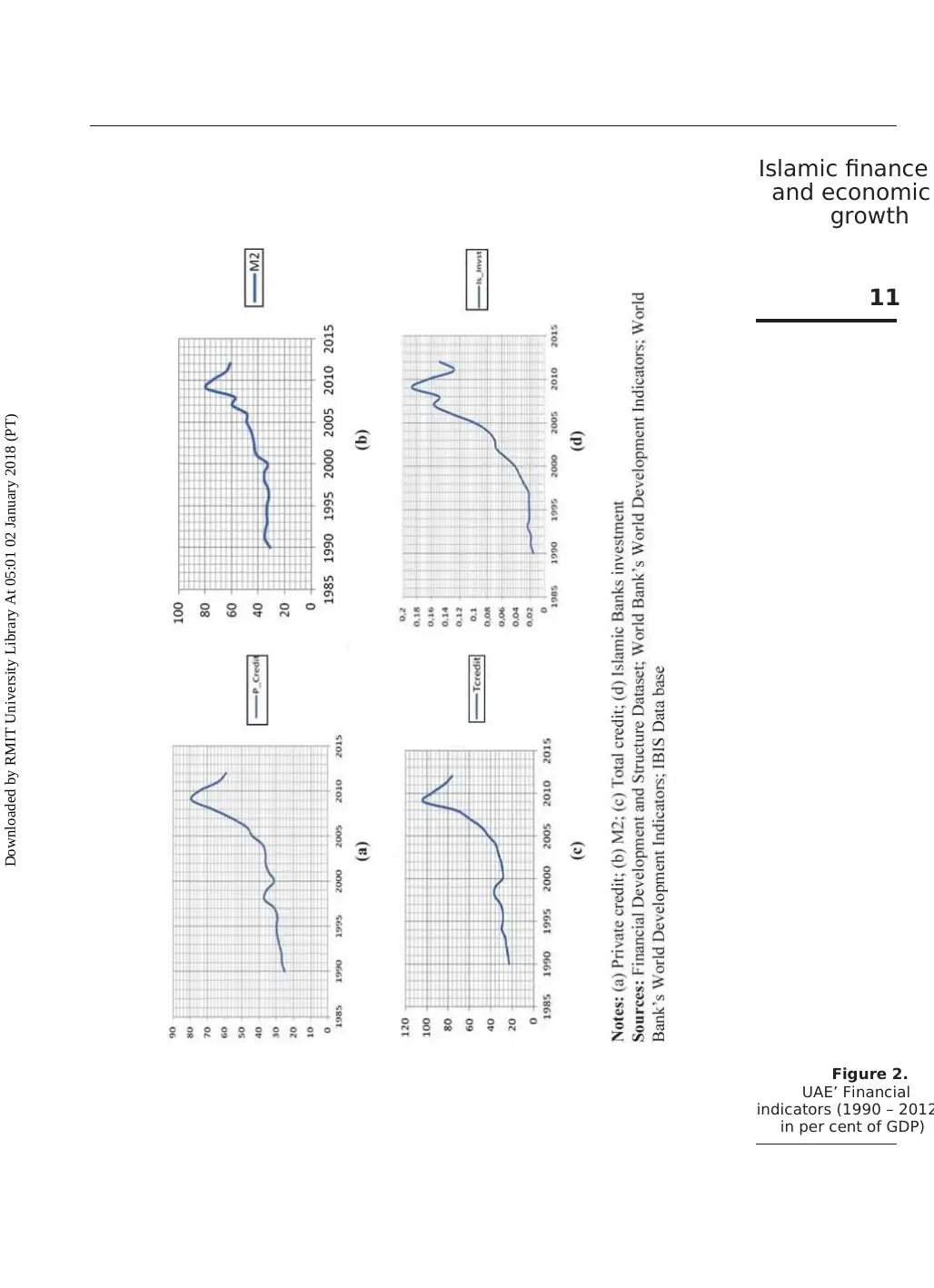
Figure 2.
UAE’ Financial
indicators (1990 – 2012
in per cent of GDP)
11
Islamic finance
and economic
growth
Downloaded by RMIT University Library At 05:01 02 January 2018 (PT)
UAE’ Financial
indicators (1990 – 2012
in per cent of GDP)
11
Islamic finance
and economic
growth
Downloaded by RMIT University Library At 05:01 02 January 2018 (PT)
⊘ This is a preview!⊘
Do you want full access?
Subscribe today to unlock all pages.

Trusted by 1+ million students worldwide
1 out of 23
Your All-in-One AI-Powered Toolkit for Academic Success.
+13062052269
info@desklib.com
Available 24*7 on WhatsApp / Email
![[object Object]](/_next/static/media/star-bottom.7253800d.svg)
Unlock your academic potential
Copyright © 2020–2025 A2Z Services. All Rights Reserved. Developed and managed by ZUCOL.

